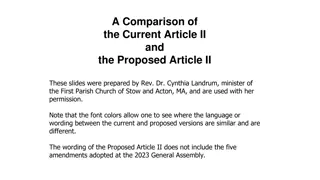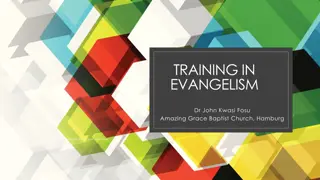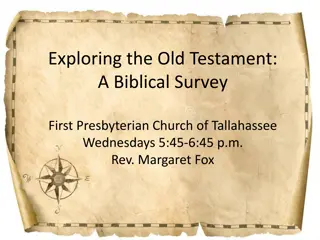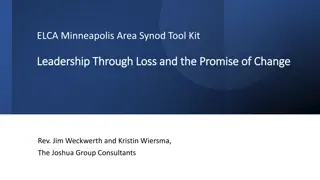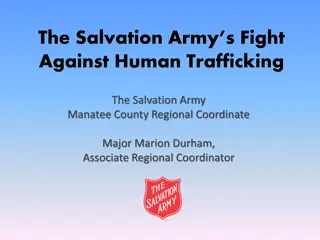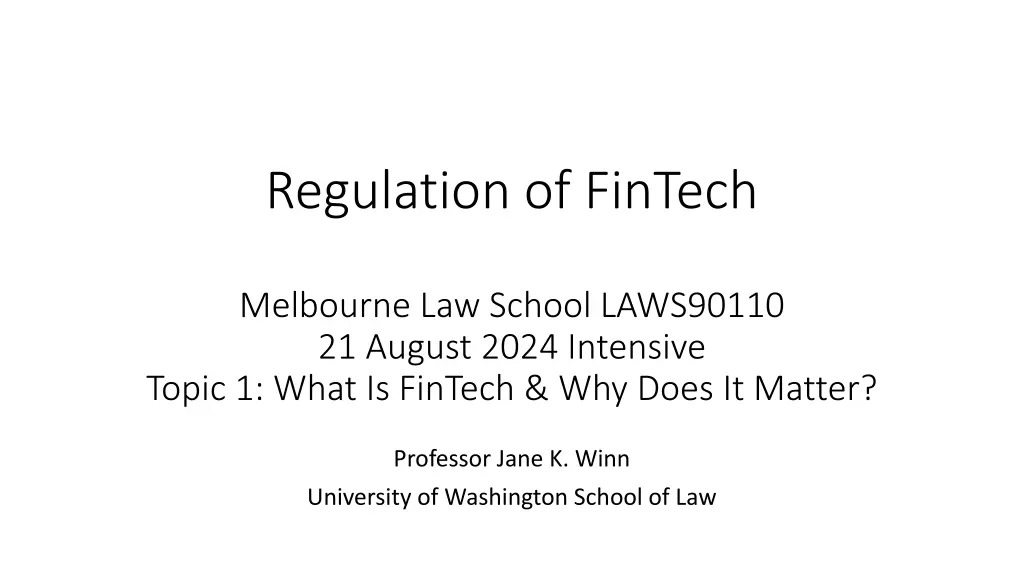
Understanding the Significance of FinTech in Today's Business Environment
Delve into the world of FinTech with Professor Jane K. Winn as she discusses the importance of financial technology and its impact. Explore topics ranging from business and politics of banking to regulation and governance in this comprehensive course schedule. Gain insights into the ever-evolving landscape of technology in finance and learn about key concepts such as EFTs, mobile payments, and crypto. Discover how these topics interconnect and why they are crucial for anyone interested in the intersection of finance and technology.
Download Presentation

Please find below an Image/Link to download the presentation.
The content on the website is provided AS IS for your information and personal use only. It may not be sold, licensed, or shared on other websites without obtaining consent from the author. If you encounter any issues during the download, it is possible that the publisher has removed the file from their server.
You are allowed to download the files provided on this website for personal or commercial use, subject to the condition that they are used lawfully. All files are the property of their respective owners.
The content on the website is provided AS IS for your information and personal use only. It may not be sold, licensed, or shared on other websites without obtaining consent from the author.
E N D
Presentation Transcript
Regulation of FinTech Melbourne Law School LAWS90110 21 August 2024 Intensive Topic 1: What Is FinTech & Why Does It Matter? Professor Jane K. Winn University of Washington School of Law
Winn Regulation of FinTech 21 Aug 2024 Course administration Reading Guide Tentative course schedule Choice of final exam versus research paper August 2022 Final Exam & Ideas for Research Papers Course Learning Outcomes Topic 1: What Is FinTech & Why Does It Matter? Lunch Break Topic 2: Business & Politics of Banking
Course Topics (Modules) Topic 1: What Is FinTech & Why Does It Matter? Topic 2: Business & Politics of Banking Topic 3: Tech Innovation/New Way of Seeing Topic 4: Regulation & Governance Topic 5: EFTs & Payment Cards Topic 6: Mobile Payments Topic 7: Crypto & CBDC Topic 8: Data Govern & Open Banking Please read the annotated Table of Contents document posted to the course website to get an idea of how these topics all fit together
Tentative Course Schedule Wed 21 August 2024 Thurs 22 August 2024 Sat 25 Aug 2024 Sun 26 Aug 2024 Mon 26 August 2024 Tues 27 August 2024 Fri 23 August 2024 Morning 9:00-12:30 10:30 am 30 min break Morning 9:00-12:30 10:30 am 30 min break Morning 9:00-12:30 10:30 am 30 min break Morning 9:00-12:30 10:30 am 30 min break Morning 9:00-12:30 10:30 am 30 min break Topic 1: What Is FinTech & Why Does It Matter? Case Study Topic 5: EFTs & Payment Cards Case Study Topic 8: Data Govern & Open Banking Framework Topic 3: Tech Innovation Finish anything leftover Aug 21-12 Meetings with students wishing to propose paper topics Lunch 12:30-1:30 Lunch 12:30-1:30 Lunch 12:30-1:30 Lunch 12:30-1:30 Lunch 12:30-1:30 Afternoon 1:30-5:00 3:00 pm 30 min break Afternoon 1:30-5:00 3:00 pm 30 min break Afternoon 1:30-5:00 3:00 pm 30 min break Afternoon 1:30-5:00 3:00 pm 30 min break Afternoon 1:30-5:00 3:00 pm 30 min break Framework Topic 2: Business & Politics of Banking Framework Topic 4: Regulation & Governance Case Study Topic 6: Mobile Payments Case Study Topic 7: Crypto & CBDC Finish Up & Exam Review
Choice of Take Home Final Exam or Research Essay Assessment 1: Class participation throughout the teaching period: [presumed all students meet this standard] Assessment 2, Option 1: 90% Take-home examination 5,000-6,000 [2,500-3,000 per answer] words 11-14 October 2024 Answer one question from group A and one question from group B Each answer should refer to at least 5 readings (full citations *NOT* required e.g., 01A Cato Fragile = sequence number, one word for author, one word for title) Assessment 2, Option 2: 90% Research paper on topic approved by the subject coordinator 7,500-9,000 words 11 November 2024 Thesis statement https://wts.indiana.edu/writing-guides/how-to-write-a-thesis- statement.html approved in writing by instructor before 5 p.m. AEST last day of course One-page summary in complete sentences by 29 September 2024 approved in writing by instructor Incorporate analysis of 10 required readings (full citations to assigned readings *NOT* required, OK to use my name for it, e.g., 01A ) 10%
Learning Outcomes Understand the strengths and weaknesses of the modern business of banking, the conventional approach to banking regulation, and role of commercial banks in modern economies Recognize the most important forms of technological innovations that are disrupting modern financial markets by making it feasible for start-up companies to compete with banks Assess the functions of global governance institutions including how to distinguish them from conventional modern national regulation and multilateral coordination among national regulators Understand how the customers and consumers of conventional financial services are being converted into users and stakeholders by new service delivery models and channels Recognize how risks and rewards are allocated among the different participants in conventional and disruptive financial services under conventional regulatory frameworks, new governance frameworks, and private agreements Assess the strengths and weaknesses of public, private, global and local systems of regulating financial services Appreciate the major themes of the course and their relevance to the different topics in the syllabus.
Self-Introduction Grew up in Midland, Michigan (father worked for Dow Chemical) France (Au Pair/studied French) Graduated Queen Mary College, University of London B.Sc.(Econ) 1980 Worked in retail brokerage office in New York City for 2 years Visited Australia for the first time in 1984, visited Guangzhou, China on the way back to the US Studied Chinese in Taiwan 1985-86 Graduated Harvard Law School 1987 Worked in Wall Street Law firm for 2 years 1989 Joined Southern Methodist University, Dallas, Texas 2001 Taught short course on E-Commerce Law at Melbourne Law School for the first time 2002 Joined University of Washington, Seattle Washington Other law schools visited/taught short courses Peking University Tsinghua University (Beijing) Chulalongkorn University University Jean Moulin Lyon III National Tsinghua University (Hsinchu) Zhejiang University Hong Kong University National Law University Odisha Peking University School of Transnational Law (Shenzhen)
Why Do I Care About Regulation of FinTech? Undergraduate research thesis on the rise of the Eurodollar (now Eurocurrency) market in Europe 1950s-1970s Worked in brokerage firm in New York City While studying Chinese in Taiwan 1985-86, studied rise of informal finance Practiced commercial law/banking law in New York Teaching/research in commercial law, banking law, law & development, comparative law, technology and law 2008 Kenya s M-Pesa suddenly made mobile payments a hot topic 2014 Rise of FinTech in London suddenly made comparative technology & law for financial services a hot topic Not enough student interest to teach Regulation of FinTech at UW Law, but: 2013 taught International E-Commerce Law at Tsinghua (Beijing) for the first time (11 times total) 2018 taught Regulation of FinTech at MLS for the first time (this is 4thtime) 2019 taught Regulation of FinTech at PKUSTL (Shenzhen) for the first time (5 times total) Main takeaway? Whichever country figures out how to disseminate a new way of seeing the interaction of law & technology most thoroughly will enjoy a sustainable competitive advantage in global markets No one can predict the future, but if I had to guess, I d guess China will find a way to do that before the West, and Open Banking provides a useful case study to show why that might happen
Topic 1: What Is FinTech & Why Does It Matter? 2024 Can Fintech replace banks 2024 Castles to Ecosystems Evolution of Banking Software 2024 Important Key Performance Indicators for FinTechs 2015 How APIs Are Disrupting The Way We Think 2024 Keeping up with API Standards for Finance TechCrunch FinTech Failures 2023 Maersk IBM abandon blockchain TradeLens platform 2024 Is Silicon Valley a Ponzi Scheme 2019-deloitte-digital-transformation-hits-core-banking 2017 Banks should let ancient programming language COBOL die 2017 YCombinator Why Banks Still Use Mainframes COBOL excerpt GAO 2019 Federal Agencies Need to Update Critical Legacy Systems GAO 2023 Federal Agencies Still Need to Update Critical Legacy Systems 2003 Evans Domain Driven Design Intro and Ch1 1992 Fosdick Sociology of Technology Adoption 2023 Web3 Explained 2024 Duke University FinTech Law Policy Coursera
2024 Can Fintech replace banks? What do FinTechs do? Payment processing and personal finance Business lending What do Banks do? Take deposits, lend money, process payments Licensed by the government, heavily regulated What challenges do FinTechs face? Burdensome compliance obligations created with banks in mind Security and privacy problems Rapid pace of technological change High cost of customer acquisition compared to per customer revenue What challenges do Banks face? Unbundling of banking services, disintermediation of banks Prohibition on engaging in commerce or industry Difficulty of updating computer systems as IT budget spent to meet heavy regulatory burdens Difficulty of competitive differentiation if every bank has the same license and is prohibited from adopting most innovations Is Bank-FinTech collaboration the most likely outcome?
2024 Castles to Ecosystems Evolution of Banking Software In the 1960s, almost no one had computers except governments, banks and airlines Before U.S. antitrust enforcement against IBM, hardware and software were bundled together in monolithic mainframe systems In 2024, all U.S. banks use only handful of software programs written in the 1960s which are very fast, very stable and completely paid for ( COBOL castles ) As computers and computer network technology evolved, the design of computers became more modular with object oriented programming In 1970s, businesses could buy microcomputers (not very small, the size of a refrigerator) instead of mainframe computers as big as a house In the 1980s, some businesses adopted a client-server computing model and gave some employees desktop computers In the 1990s, everyone was given a computer and access to the internet, vendors of large computer systems adopted service-oriented architecture (computer adapts to human rather than vice versa) In 2000s, microservices model became popular (using application programming interfaces to connect the different microservices ) Banks now have multiple computer systems: Mainframe computer with core banking system for basic accounting operations, middleware (half way between software and hardware) connects mainframe to more modern systems: Client-server to support employees Internet and mobile banking for customers Moving the whole thing slowly to microservices whenever possible
2024 Important Key Performance Indicators for FinTechs FinTechs are startup companies that must persuade private investors to give them enough money to successfully launch their new business model before those investors exit (sale to another company or initial public offering) This list of key performance indicators helps company management and outside investors monitor the health of the FinTech Knowing how much money is in petty cash is just data, it is not a key performance indicator Knowing whether someone completed a petty cash reimbursement form for every withdrawal from petty cash is a key performance indicator for monitoring employee fraud KPIs provide information about how much progress has been made in achieving a goal These KPIs the same as for any other tech startup, there is nothing about these KPIs that are specific to banking regulation
APIs Old & New The term application programming interface has been used in programming since at least the 1980s, but did not gain widespread attention until the 2000s There are many different theories about who first popularized APIs as fundamental building blocks of online commerce. In the late 1990s, Jeff Bezos told the employees of Amazon that he would fire anyone who wrote any software that could not communicate with everyone else in the organization, and required software developers to set up systems to share information across departments. This may be the first time any business focused on APIs as a source of competitive advantage, but the label API wasn t initially used.
2015 How APIs Are Disrupting The Way We Think Netflix and Amazon computer systems are highly modular, and data passes between different parts of their computer systems using APIs Netflix was competing against older companies like Blockbuster Video that had a centralized computer system and gave employees computers to look inside that system Amazon was competing against older companies like Ingraham Books, the largest book wholesaler in America with a centralized computer system that every bookstore in America could access by computer. Ingraham gave Amazon permission to search its database of books and place orders with it when Amazon started. The success of the Apple App Store and Google Play has taught everyone with a smart phone what APIs can do even if they don t know APIs are the technology that make phone apps work so well
Stripe is one of the most valuable FinTechs in the world, it is an API https://stripe.com/au/resources/more/payment-application- program-interfaces-apis What kind of services does Stripe provide to businesses that want to receive consumer payments? Transaction APIs Subscription APIs Tokenisation APIs Payout APIs Preauthorisation APIs Data and reporting APIs
What Is Screen Scraping? Move data from one computer system to another indirectly and often without first computer system operator s permission Global Distribution Systems (air, car, hotel, train etc) develop web interfaces: Travelocity, Expedia, Orbitz Data aggregators scrape data from GDS websites and offer comparison data because they don t want to pay for a license to the data and the GDS don t want direct comparisons Kayak, Skyscanner, Hotwire eBay v. Bidder s Edge case in 2000: eBay successful stopped a competitor from copying and redisplaying price information Quicken, Mint.com: consumer provides financial institution website user ID and password, Quicken or Mint pretends to be the customer, downloads account information to allow consumer to see all their financial accounts at once
What is an Application Programming Interface API and why does it matter to banking & FinTech? https://www.timeanddate.com/ What is timeanddate.com s business model? Advertising Freemium services: basic are free, advanced are paid What is the channel through which paid services are delivered? API
2024 Keeping up with API Standards for Finance If every bank and every FinTech try to establish their own APIs for all the data they share with other organizations, then nothing will work because programmers can t learn to use so many different APIs Standards are what make networks possible If different organizations agree on standards for APIs then that removes barriers to the business use of APIs with banks and FinTechs But standardization increases competition and lowers the profits of banks and FinTechs so they don t want standard APIs, they all want to publish an API that becomes more popular than the Stripe APIs Just like with a model law, writing out a standard doesn t guarantee anyone will use it, so most businesses adopt a wait and see approach Topic 8 on Data Governance & Open Banking will examine government open banking mandates in more depth Regulators want to increase competition in banking and are trying to force banks to publish APIs to make it possible for FinTechs to compete with them Open banking does not (yet?) appear to be working, regulators seem to be trying to push a wet noodle https://en.wikipedia.org/wiki/Wet_noodle
TechCrunch FinTech Failures Roboadvisors to help individuals choose investments Peer-to-Peer lending and insurance Standalone financial planning apps (rather than offered inside, e.g., a mobile banking app) Copy other people s trading strategies Match investors with investment advisors Retirement planning services Student education loan apps
2018 Tweet by Vint Cerf https://en.wikipedia.org/wiki/Vint_Cerf
2023 Maersk IBM abandon blockchain TradeLens platform There is a problem in International Trade Finance that people have been trying to solve since the 1980s without success: how to transfer ownership of cargo on a ship without a paper bill of lading? Maersk and IBM launched TradeLens a blockchain platform that would permit paper bills of lading to be eliminated from international trade In 2023, Maersk and IBM announced the platform was closing Blockchain was an irrelevant distraction Maersk and IBM tried to use market power not collaboration to drive adoption So how to convert bill of lading from paper to electronic form? Digital Container Shipping Association is trying to launch a technology neutral collaborative effort https://dcsa.org/newsroom/dcsas-member-carriers-commit-to- a-fully-standardised-electronic-bill-of-lading-by-2030
2024 Is Silicon Valley a Ponzi Scheme? Charles Ponzi https://en.wikipedia.org/wiki/Charles_Ponzi defrauded American investors in the 1920s by promising high returns, but he merely used money deposited by recent investors to pay fake high returns to early investors From the 1950s-1980s, venture capitalists in Silicon Valley invented a new system for financing technology startup companies Silicon Valley companies were originally U.S. government defense contractors, some employees could leave big companies to start new companies because California does not enforce non-compete agreements After the Dot-Com bubble burst in 2000, venture capitalists became more cynical; after Global Financial Crisis, they became even more cynical Pump and dump schemes involve early investors spreading untrue rumors about companies to drive up their share prices, then dumping before the inevitable crash Almost no public investors have made money off of next big thing tech stock public offerings for more than a decade, but venture capitalists have still made money
2019 Deloitte digital transformation hits core banking Banks want to retire their old legacy monolithic mainframe computer systems but regulators will not let them do that unless there is no downtime and no errors during the transition which is almost impossible to achieve Each legacy monolithic mainframe computer system is unique Computer science departments to not teach how to work on them Consultants make a lot of money advising companies on how to maintain them or transition them but there is no guarantee of success Banking industry efforts to develop standards to lower cost and increase success are proceeding slowly, e.g, https://bian.org/
2017 Banks should let ancient programming language COBOL die This article is the one that triggered the discussion in the YCombinator subreddit
2017 Y Combinator Why Banks Still Use Mainframes COBOL excerpt Y Combinator is one of the most successful startup accelerators in the world: https://en.wikipedia.org/wiki/Y_Combinator In 2017, a software developer and member of a subreddit discussion group managed by Y Combinator asked why banks don t get rid of their COBOL mainframe programs as the author of the article suggested they should. This triggered a lively discussion in which more experienced software developers trying to explain how incredibly slow and difficult the process is and how success is never guaranteed
GAO 2019 Federal Agencies Need to Update Critical Legacy Systems GAO 2023 Federal Agencies Still Need to Update Critical Legacy Systems Companies never disclose the problems they are having migrating their legacy mainframe computer systems to newer technology architectures unless they have to 2012 Royal Bank of Scotland fined by UK regulators for crashing its core banking system after trying to save money by outsourcing maintenance to India https://www.bbc.com/news/business-30125728 2014 Indian tech company hired by UK Coop Bank to manage the migration of its core banking system was unable to complete the project, so the bank had to go back to the original system after wasting years and millions of pounds https://www.theguardian.com/business/2015/jun/23/cooperative-bank-timeline- troubles The Government Accountability Office investigates for U.S. Congress what the U.S. Executive Branch is doing and reports on Executive Branch failures GAO has been reporting problems with U.S. government monolithic mainframe computer system for decades, the problem never seems to get any better
2003 Evans Domain Driven Design Intro and Ch1 Before proposing a solution, a software developer must understand both the client s current situation and the client s goals If the developer starts writing software code before understanding that, then the software will not solve the client s problems The client does not understand software development and does not know how to explain what they want to the developer so quickly become frustrated The developer does not initially understand what the client wants but must not allow themselves to be frustrated Requirements elicitation in software development requires a combination of anthropology, journalism and psychological counseling skills Most programmers got into that profession because they were good at math and science but lacked soft people skills Domain Driven Design is a classic reference book for software developers trying to implement microservices If done correctly, then the business should never end up with the same problem again (the new system becomes the old system and does not fulfil the organization s needs)
8 Lessons from 20 Years of Hype Cycles 2016 Lesson 1. We're terrible at making predictions. Especially about the future. Lesson 2. An alarming number of technology trends are flashes in the pan. Lesson 3. Lots of technologies just die. Period. Lesson 4: The technical insight is often correct, but the implementation isn't there. Lesson 5: We've been working on a few core technical problems for decades. Lesson 6: Some technologies keep receding into the future. Lesson 7: Lots of technologies make progress when no-one is looking. Lesson 8: Many major technologies flew under the Hype Cycle radar.
2023 Web3 Explained Silicon Valley venture capitalists at Andreessen Horwitz invented the term Web3 to sell the companies they invest in to other companies or the public Web 1.0 was simple static web pages Web 2.0 allowed for collaboration and reuse The Machine is Us/ing Us (Final Version) https://www.youtube.com/watch?v=NLlGopyXT_g Web3 (not Web 3.0) is supposed to be decentralized with blockchain/crypto technology
2024 Duke University FinTech Law Policy Coursera By the end of this class, you should be able to explain why there is so much hype surrounding crypto, blockchain, Web3 even though there are no legitimate uses for any of it and no one is making any money from it except criminals, and dishonest venture capitalists and consultants Shill: in auctions or in gambling casinos, the management may place fake customers with real ones to drive up prices and cause the real customers to lose more money I m shilling for the owner of the painting being auctioned I m a shill for the house (i.e., casino) When lawyers promote technologies that don t work, they are violating their fiduciary duties to the public and their clients by shilling (intentionally or unintentionally) for criminals, and dishonest venture capitalists and consultants How can someone without a computer science degree spot scams like Web3? This will be explored over the course of the course














